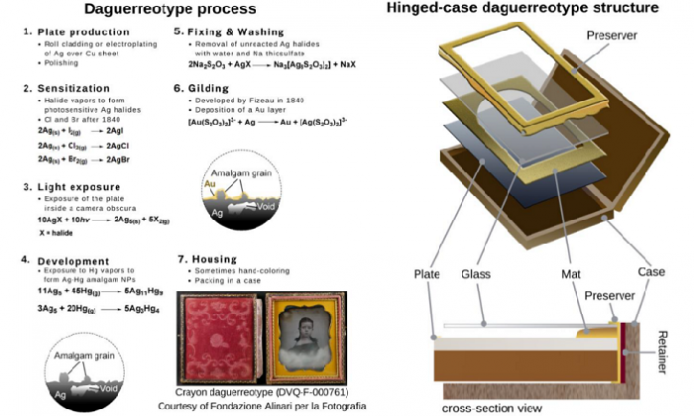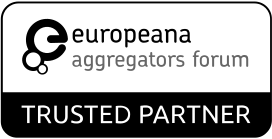img. from the paper, showing on the left the steps of the process with the listed chemical reactions, and on the right the scheme of the structure of a hinged-case daguerreotype (TDVQ-F-000761, courtesy of Fondazione Alinari per la Fotografia) with the different elements indicated to show its multi-material complexity.
Learn more about research on nine daguerreotypes from the Fondazione Alinari per la Fotografia, including the use of optical coherence tomography (OCT) to study its cross-sections without taking samples. The results of this reserach allowed the characterization, in a non-invasive mode at a microscopic level, of a wide range of degradation products produced by the interaction of the different elements present in the structure of the daguerreotypes
The Degradation of Daguerreotypes and the Relationship with Their Multi-Material Structure: A Multimodal Investigation
by Diego Quintero Balbas, Barbara Cattaneo, Andrea Cagnini, Paolo Belluzzo, Sandra Rossi, Raffaella Fontana and Jana Striova
Sensors 2023, 23(9), 4341; https://doi.org/10.3390/s23094341
Received: 13 March 2023 / Revised: 19 April 2023 / Accepted: 25 April 2023 / Published: 27 April 2023
(This article belongs to the Special Issue Advanced Sensing Technologies in Archaeology and Heritage)
Abstract:
Preserving and analytically examining daguerreotypes is particularly challenging because of their multi-material and multi-component structure. Various sensors have been exploited to examine mainly the image plates of the daguerreotypes even though the degradation goes beyond this component. Micro-analyses have been the preferred method due to the nanoscale structure of the image particles. In this work, we propose comprehensive multi-modal non-invasive sensing to investigate the corrosion products present in nine daguerreotypes from the Fondazione Alinari per la Fotografia (FAF, Florence, Italy). The methodology proposed includes chemical and morphological analyses: portable X-ray fluorescence spectrometry (pXRF), Raman microspectroscopy (μ-Raman), and micro-Fourier transform infrared spectroscopy in reflection mode (μ-rFTIR) for the chemical identification. For the first time, optical coherence tomography (OCT) was deployed to record the cross-sectional and morphological data of the relevant corrosion formations on daguerreotypes in a contactless way. The results allowed the characterization, in a non-invasive mode at a microscopic level, of a wide range of degradation products produced by the interaction of the different elements present in the structure of the daguerreotypes. The aim was to verify the performance of the proposed methodology and to link the chemical and physical complexity of the entire structure, disclosed by the state-of-art sensors, to the daguerreotype degradation. The results draw attention to the need to monitor not only the image condition but the whole object as a partially closed system in constant interaction internally and with the environment.


